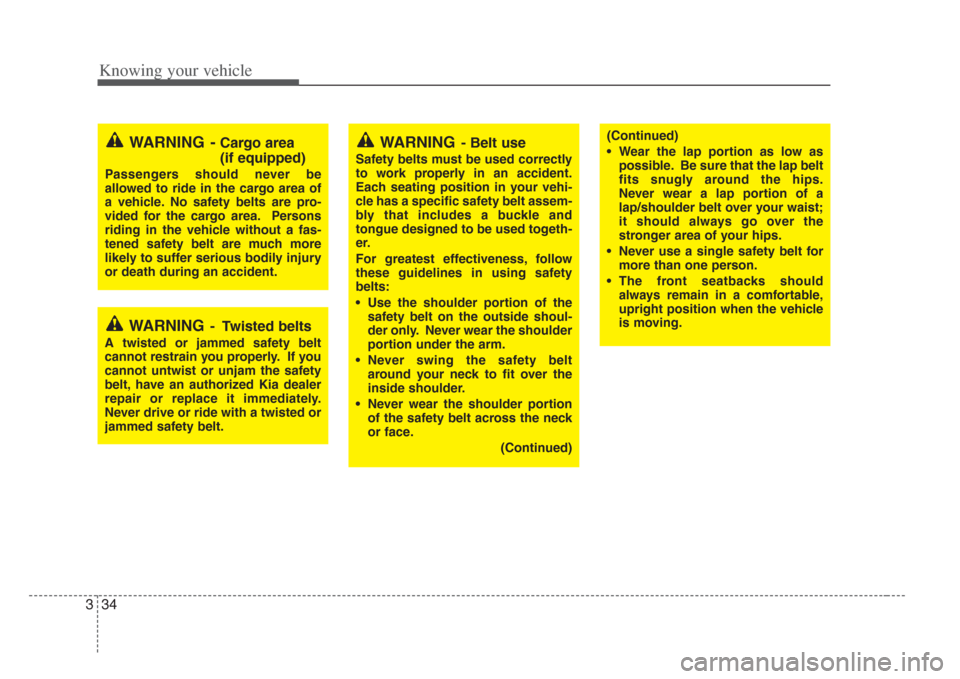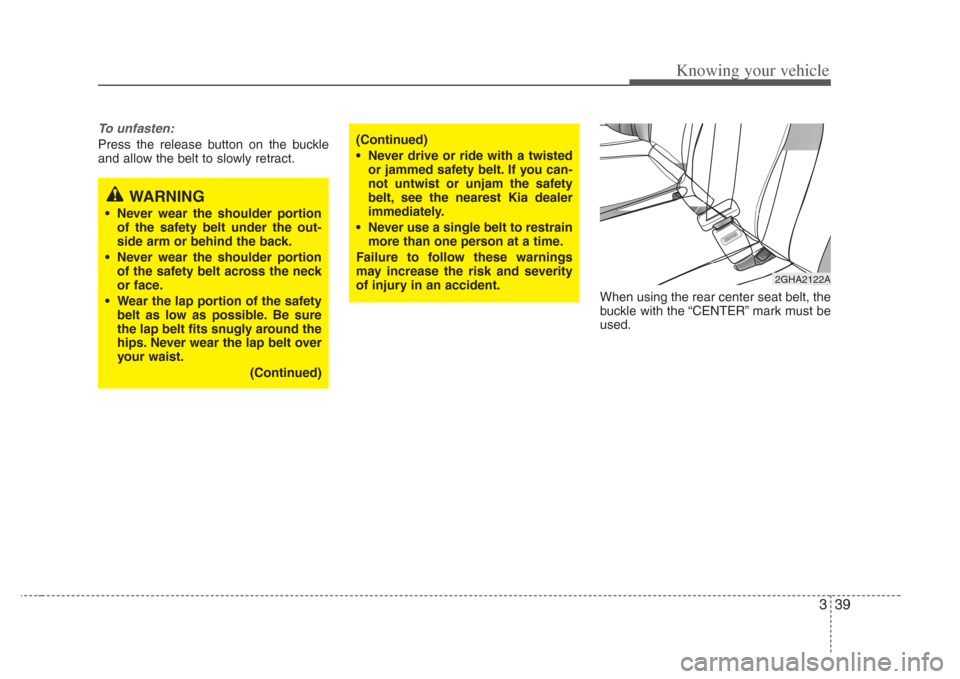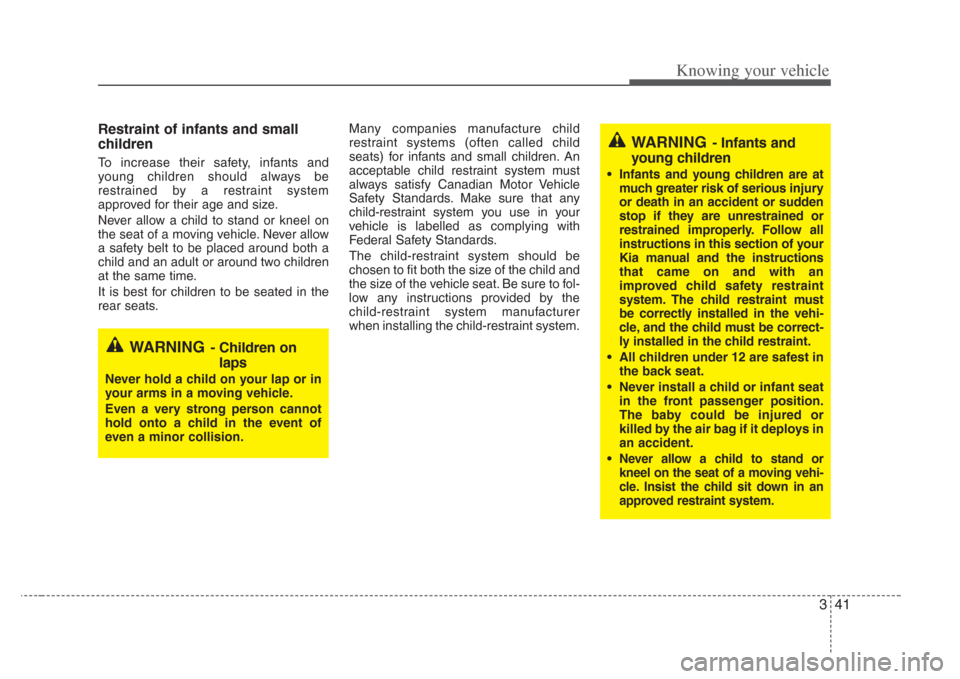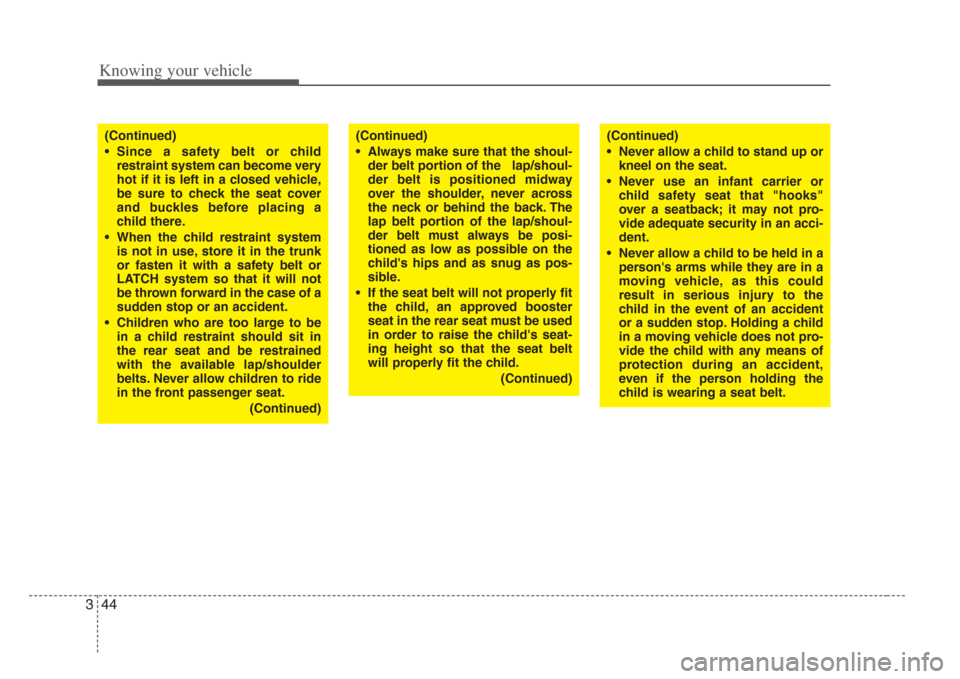2008 KIA Opirus Back seat
[x] Cancel search: Back seatPage 35 of 283

325
Knowing your vehicle
Removal
To remove the headrest, raise it as far as
it can go then press the release button
(
➀) while pulling upward (➁).
Rear seat
Armrest
The armrest is located in the center of
the rear seat. Pull the armrest down from
the seatback.
You will find a storage cover and cup
holders (if equipped).
Warming the rear passenger seats
(if equipped)
Rear seats can be electrically heated
when the ignition switch is ON.
1. Pull the armrest down using the strap provided on the armrest.
2. When the switch is ON, a number ranging from 1 to 5 is displayed on the
switch (5 = warmest setting).
To turn off the seat warmer, set the
switch to 0.
The seat warmer turns off automatically
when the seat temperature reaches the
selected range and will turn on again if
the temperature drops below the select-
ed range.
WARNING
To reduce the ri sk of head and neck
injuries, do not drive the vehicle
with the headres t removed or
improperly positioned.
Do not adju st the driver’ s headrest
while driving.
1GHA2247OGH026090NOGH036320N
left rear seat
right rear seat
Page 43 of 283

333
Knowing your vehicle
Since the inertial locks do not require a
collision in order to lock up, you may
become aware of the safety belts locking
while braking or going around sharp cor-
ners.The rear safety belts use a special auto-
lock feature designed to allow a child
restraint to be used without an added
locking clip. These safety belt positions
normally lock only under extreme or
emergency conditions (emergency lock
mode). However, they can be adjusted so
that they remain in fixed and locked when
a child restraint system is in place. (Use
this auto-lock mode only to secure a child
restraint, never for passengers restrained
by the safety belts.) Page 3-46 gives
instructions on placing the safety belt in
the auto lock mode.
The driver’s safety belt can only operate
in the emergency lock mode.Safety belts provide the best restraint
when:
• The seatback is upright.
• The occupant is sitting upright (not
slouched).
• The lap belt is snug across the hips.
• The shoulder belt is snug across the chest.
• The knees are straight forward.
To help you remember to fasten your
safety belt, a warning light will come on
and a chime will sound. See Safety Belt
Warning Light and Chime on page 3-35.
WARNING
Always u se the rear seat position(s)
to install your child restraint(s).
Never install a child restraint sys-
tem in the front passenger position,
as an inflating air bag could cau se
serious or fatal injury to a child in
that position.
WARNING- After a colli- sion
• Lap/s houlder belt assemblies
may be s tretched or damaged
when subjected to the stress and
force s of a collision.
• The entire res traint system
s hould be ins pected following
any collision. All belts, retractor s,
anchor s and hardware damaged
by a collision should be replaced
before the vehicle is operated
again.
Page 44 of 283

Knowing your vehicle
343
WARNING - Cargo area
(if equipped)
Passenger s should never be
allowed to ride in the cargo area of
a vehicle. No safety belt s are pro-
vided for the cargo area. Per sons
riding in the vehicle without a fa s-
tened safety belt are much more
likely to suffer serious bodily injury
or death during an accident.
WARNING- Twisted belts
A twisted or jammed safety belt
cannot restrain you properly. If you
cannot untwi st or unjam the safety
belt, have an authorized Kia dealer
repair or replace it immediately.
Never drive or ride with a twisted or
jammed safety belt.
WARNING- Belt use
Safety belts mu st be used correctly
to work properly in an accident.
Each seating po sition in your vehi-
cle has a specific safety belt assem-
bly that includes a buckle and
tongue designed to be used togeth-
er.
For greatest effectiveness, follow
thes e guidelines in using safety
belts:
•U se the shoulder portion of the
safety belt on the out side shoul-
der only. Never wear the shoulder
portion under the arm.
• Never swing the s afety belt
around your neck to fit over the
inside shoulder.
• Never wear the shoulder portion of the safety belt across the neck
or face.
(Continued)
(Continued)
• Wear the lap portion a s low as
possible. Be sure that the lap belt
fits snugly around the hips .
Never wear a lap portion of a
lap/shoulder belt over your wai st;
it should always go over the
stronger area of your hip s.
• Never use a single safety belt for
more than one per son.
• The front s eatbacks should
always remain in a comfortable,
upright po sition when the vehicle
is moving.
Page 47 of 283

337
Knowing your vehicle
5. Adjust the shoulder anchor position toyour size. To raise the anchor position,
push the anchor up (
➀). To lower the
anchor position, press the button (
➁)
and slide the anchor down (
➂). After
adjustment, make sure the anchor is
locked in position.
To unfasten the front lap/shoulder belt:
Press the release button on the buckle
and allow the belt to slowly retract.
MMSA30265GHN3900
WARNING
• The height adju ster must be in
the locked pos ition when the
vehicle is moving.
• The misadjustment of height of the shoulder belt could reduce
the effectiveness of the seat belt
in a crash.
WARNING
• The seatbacks should always
remain in a comfortable, upright
position while the vehicle is in
motion. The safety belt system
will provide the most protection
with the seatbacks in an upright
position.
• Never wear the shoulder portion of the safety belt under the out-
side arm or behind the back.
• Never wear the shoulder portion of the safety belt across the neck
or face.
• Wear the lap portion of the safety
belt as low on the hips a s possi-
ble. Be sure the lap belt fits snug-
ly around the hip s. Never wear the
lap belt over your wai st.
(Continued)
Page 49 of 283

339
Knowing your vehicle
To unfasten:
Press the release button on the buckle
and allow the belt to slowly retract.When using the rear center seat belt, the
buckle with the “CENTER” mark must be
used.
WARNING
• Never wear the shoulder portionof the safety belt under the out-
side arm or behind the back.
• Never wear the shoulder portion of the safety belt across the neck
or face.
• Wear the lap portion of the safety
belt as low as possible. Be sure
the lap belt fits snugly around the
hips. Never wear the lap belt over
your waist.
(Continued)
(Continued)
• Never drive or ride with a twi sted
or jammed safety belt. If you can-
not untwist or unjam the safety
belt, see the nearest Kia dealer
immediately.
• Never use a single belt to restrain more than one per son at a time.
Failure to follow thes e warnings
may increase the risk and severity
of injury in an accident.
2GHA2122A
Page 51 of 283

341
Knowing your vehicle
Restraint of infants and small
children
To increase their safety, infants and
young children should always be
restrained by a restraint system
approved for their age and size.
Never allow a child to stand or kneel on
the seat of a moving vehicle. Never allow
a safety belt to be placed around both a
child and an adult or around two children
at the same time.
It is best for children to be seated in the
rear seats. Many companies manufacture child
restraint systems (often called child
seats) for infants and small children. An
acceptable child restraint system must
always satisfy Canadian Motor Vehicle
Safety Standards. Make sure that any
child-restraint system you use in your
vehicle is labelled as complying with
Federal Safety Standards.
The child-restraint system should be
chosen to fit both the size of the child and
the size of the vehicle seat. Be sure to fol-
low any instructions provided by the
child-restraint system manufacturer
when installing the child-restraint system.
WARNING- Children on
laps
Never hold a child on your lap or in
your arms in a moving vehicle.
Even a very strong per son cannot
hold onto a child in the event of
even a minor collision.
WARNING- Infants and
young children
• Infants and young children are at
much greater ris k of serious injury
or death in an accident or s udden
s top if they are unres trained or
res trained improperly. Follow all
ins tructions in this s ection of your
Kia manual and the ins tructions
that came on and with an
improved child s afety restraint
s ystem. The child res traint must
be correctly ins talled in the vehi-
cle, and the child mus t be correct-
ly in stalled in the child res traint.
• All children under 12 are safest in the back seat.
• Never install a child or infant seat in the front passenger position.
The baby could be injured or
killed by the air bag if it deploys in
an accident.
•
Never allow a child to s tand or
kneel on the s eat of a moving vehi-
cle. In sis t the child s it down in an
approved res traint system.
Page 54 of 283

Knowing your vehicle
443
(Continued)
• Since a safety belt or child
restraint system can become very
hot if it is left in a closed vehicle,
be sure to check the seat cover
and buckles before placing a
child there.
• When the child re straint system
is not in use, store it in the trunk
or fasten it with a safety belt or
LATCH system so that it will not
be thrown forward in the ca se of a
sudden stop or an accident.
• Children who are too large to be in a child restraint should sit in
the rear seat and be restrained
with the available lap/s houlder
belts. Never allow children to ride
in the front passenger seat.
(Continued)(Continued)
•Alway s make sure that the shoul-
der belt portion of the lap/ shoul-
der belt is positioned midway
over the shoulder, never across
the neck or behind the back. The
lap belt portion of the lap/shoul-
der belt mus t always be pos i-
tioned as low as possible on the
child's hips and as snug as pos-
sible.
• If the seat belt will not properly fit the child, an approved boo ster
seat in the rear seat must be used
in order to rai se the child's seat-
ing height so that the seat belt
will properly fit the child.
(Continued)(Continued)
• Never allow a child to stand up orkneel on the seat.
• Never us e an infant carrier or
child safety seat that "hooks "
over a seatback; it may not pro-
vide adequate security in an acci-
dent.
• Never allow a child to be held in a per son's arms while they are in a
moving vehicle, as this could
res ult in s erious injury to the
child in the event of an accident
or a sudden stop. Holding a child
in a moving vehicle doe s not pro-
vide the child with any mean s of
protection during an accident,
even if the per son holding the
child is wearing a seat belt.
Page 58 of 283

Knowing your vehicle
483
✽NOTICE
When the safety belt is allowed to
retract to its fully stowed position, the
retractor will automatically switch from
the “Auto Lock” mode to the emergency
lock mode for normal adult usage.
Securing a child re straint seat with
“Tether Anchor” system
Child restraint hook holders are located
on the shelf behind the rear seats.
1. Open the tether anchor cover on the
shelf behind the rear seats. 2. Route the child restraint seat strap
over the seatback.
For vehicles with adjustable headrest,
route the tether strap under the head-
rest and between the headrest posts,
otherwise route the tether strap over
the top of the seatback.
3. Connect the tether strap hook to the correct child restraint hook holder and
tighten to secure the seat.
WARNING- Auto lockmode
The lap/shoulder belt automatically
returns to the “emergency lock
mode” whenever the belt i s allowed
to retract fully. Therefore, the pre-
ceding seven steps mu st be fol-
lowed each time a child re straint is
installed.
If the s afety belt is not placed in the
“auto lock” mode, severe injury or
death could occur to the child
and/or other occupants in the vehi-
cle in a collis ion,since the child
res traint will not be effectively held
in place.
6GHA2025OGH036330N